
The Ediacaran Period is a geological period that spans 96 million years from the end of the Cryogenian Period 635 million years ago (Mya), to the beginning of the Cambrian Period 538.8 Mya. It marks the end of the Proterozoic Eon, and the beginning of the Phanerozoic Eon. It is named after the Ediacara Hills of South Australia.
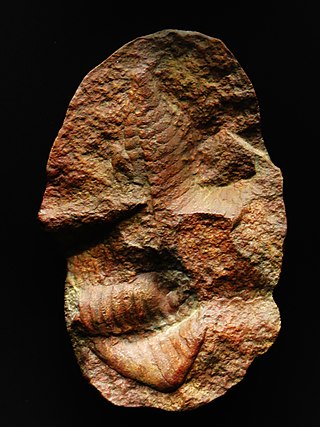
Pteridinium is an erniettomorph found in a number of Precambrian deposits worldwide. It is a member of the Ediacaran biota.

Dickinsonia is an extinct genus of basal animal that lived during the late Ediacaran period in what is now Australia, China, Russia and Ukraine. The individual Dickinsonia typically resembles a bilaterally symmetrical ribbed oval. Its affinities are presently unknown; its mode of growth is consistent with a stem-group bilaterian affinity, though some have suggested that it belongs to the fungi, or even an "extinct kingdom". The discovery of cholesterol molecules in fossils of Dickinsonia lends support to the idea that Dickinsonia was an animal.

Ediacara Hills are a range of low hills in the northern part of the Flinders Ranges of South Australia, around 650 kilometres (400 mi) north of the state capital of Adelaide. The hills are known for being the location of significant fossils, and have given their name to the geological period known as the Ediacaran.
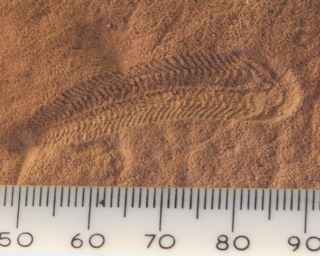
Spriggina is a genus of early bilaterian animals whose relationship to living animals is unclear. Fossils of Spriggina are known from the late Ediacaran period in what is now South Australia. Spriggina floundersi is the official fossil emblem of South Australia. It has been found nowhere else. The organism reached about 3–5 centimetres (1.2–2.0 in) in length and may have been predatory. Its bottom was covered with two rows of tough interlocking plates, while one row covered its top; its front few segments fused to form a "head."

Yorgia waggoneri is a discoid Ediacaran organism. It has a low, segmented body consisting of a short wide "head", no appendages, and a long body region, reaching a maximum length of 25 cm (9.8 in). It is classified within the extinct animal phylum Proarticulata.
Marywadea is a genus of Ediacaran biota shaped like an oval with a central ridge. It is a bilaterian organism as evidenced by its symmetry, vaguely resembling a very primitive trilobite. The fossil has an asymmetrical first chamber of the quilt. It has transverse ridges away from the central axis that may be gonads. The head is shaped as a semicircle and is the same width as the rest of the body. The ridges number about 50. There are two oval shapes below the head.
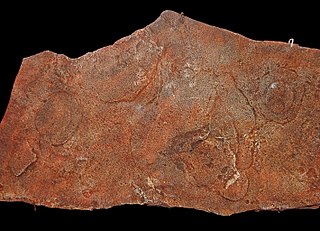
Ediacaria is a fossil genus dating to the Ediacaran Period of the Neoproterozoic Era. Unlike most Ediacaran biota, which disappeared almost entirely from the fossil record at the end of the Period, Ediacaria fossils have been found dating from the Baikalian age of the Upper Riphean to 501 million years ago, well into the Cambrian Period. Ediacaria consists of concentric rough circles, radial lines between the circles and a central dome, with a diameter from 1 to 70 cm.
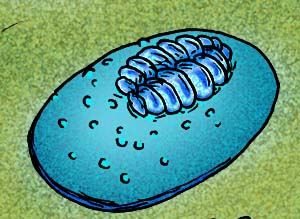
Cephalonega stepanovi is a fossil organism from Ediacaran deposits of the Arkhangelsk Region, Russia. It was described by Mikhail A. Fedonkin in 1976
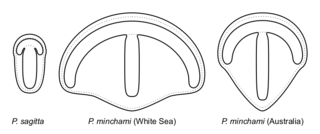
Parvancorina is a genus of shield-shaped bilaterally symmetrical fossil animal that lived in the late Ediacaran seafloor. It has some superficial similarities with the Cambrian trilobite-like arthropods.
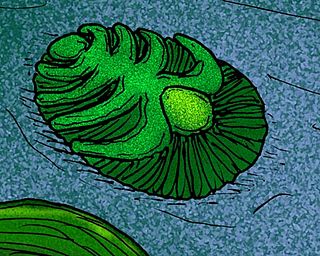
Praecambridium sigillum is an extinct organism that superficially resembles a segmented trilobite-like arthropod. It was originally described as being a trilobite-like arthropod, though the majority of experts now place it within the Proarticulata as a close relative of the much larger Yorgia. It is from the Late Ediacaran deposit of Ediacara Hills, Australia, about 555 million years ago. On average, P. sigillum had at least 5 pairs of segments, with each unit becoming progressively larger as they approach the cephalon-like head.

The Ediacaranbiota is a taxonomic period classification that consists of all life forms that were present on Earth during the Ediacaran Period. These were composed of enigmatic tubular and frond-shaped, mostly sessile, organisms. Trace fossils of these organisms have been found worldwide, and represent the earliest known complex multicellular organisms.
The end-Ediacaran extinction is a mass extinction believed to have occurred near the end of the Ediacaran period, the final period of the Proterozoic eon. Evidence suggesting that such a mass extinction occurred includes a massive reduction in diversity of acritarchs, the sudden disappearance of the Ediacara biota and calcifying organisms, and the time gap before Cambrian organisms "replaced" them. Some lines of evidence suggests that there may have been two distinct pulses of the extinction event, one occurring 550 million years ago and the other 539 million years ago.

Isomer is an element of transverse body articulation of the bilateral fossil animals of the Phylum Proarticulata from the Ediacaran (Vendian) period. This term has been proposed by Andrey Yu. Ivantsov, a Russian paleontologist from the Laboratory of the Precambrian organisms, Paleontological Institute, Russian Academy of Sciences.

Protonympha is a form genus for problematic fossils of Devonian age in New York. It has been of special interest because of its morphological similarity with the iconic Ediacaran fossil Spriggina, and may have been a late surviving vendobiont.
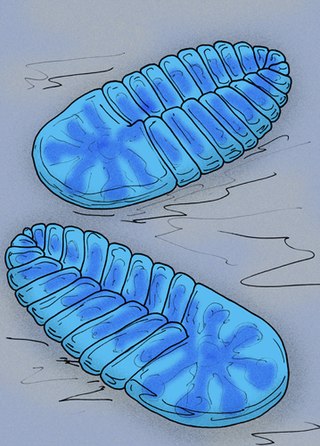
Cyanorus singularis is a small proarticulatan, closely related to Spriggina and Marywadea. Its two largest pairs of appendages are located on the anterior part of the body. The anterior part of the body was most likely not segmented. The axial structure of it combines features of the Vendia species and Dickinsonia species. It was found in the Upper Vendian of the White Sea area, Arkhangel'sk Region. It is a White Sea Ediacaran fossil and it became extinct during the Late Precambrian.

Archaeaspinus fedonkini is an extinct proarticulatan organism from the Late Precambrian (Ediacaran) period.

Cephalozoa are an extinct class of primitive segmented marine organisms within the Phylum Proarticulata from the Ediacaran period. They possessed bilateral symmetry and were characterized by a thin, rounded body.

Yorgiidae is an extinct family of cephalozoans, which lived 635 million years ago. They were filter fed.

















